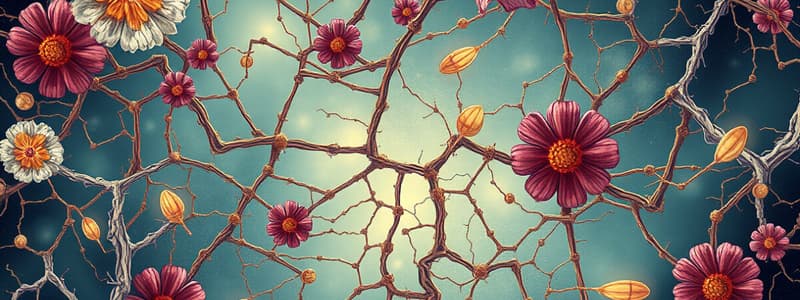Podcast
Questions and Answers
What is the primary function of macrophages in connective tissue?
What is the primary function of macrophages in connective tissue?
- Storing fat
- Mediating inflammation
- Removing bacteria and cell debris (correct)
- Secreting type III collagen
Which of the following is NOT classified as a glycosaminoglycan (GAG)?
Which of the following is NOT classified as a glycosaminoglycan (GAG)?
- Chondroitin sulfate
- Dermatan sulfate
- Proteoglycans (correct)
- Hyaluronic acid
Which type of cell is primarily responsible for producing melanin?
Which type of cell is primarily responsible for producing melanin?
- Adipocytes
- Macrophages
- Lymphocytes
- Melanocytes (correct)
What distinguishes resident cells from transient cells in connective tissue?
What distinguishes resident cells from transient cells in connective tissue?
Which of the following cells is considered a type of fibroblast?
Which of the following cells is considered a type of fibroblast?
What is the main function of fibrous connective tissues?
What is the main function of fibrous connective tissues?
Which cell type is primarily responsible for synthesizing collagen in connective tissues?
Which cell type is primarily responsible for synthesizing collagen in connective tissues?
Which characteristic distinguishes fibrous connective tissues from epithelial tissues?
Which characteristic distinguishes fibrous connective tissues from epithelial tissues?
What component of the extracellular matrix is primarily responsible for its stretchability?
What component of the extracellular matrix is primarily responsible for its stretchability?
What type of collagen is primarily found in reticular fibers?
What type of collagen is primarily found in reticular fibers?
Which statement describes the ground substance in connective tissues?
Which statement describes the ground substance in connective tissues?
What is the role of glycosaminoglycans (GAGs) in the extracellular matrix?
What is the role of glycosaminoglycans (GAGs) in the extracellular matrix?
What defines the cellular composition of fibrous connective tissues?
What defines the cellular composition of fibrous connective tissues?
Flashcards are hidden until you start studying
Study Notes
Overview of Connective Tissues (CT)
- CT consists of various extracellular components, is highly vascular, and innervated.
- Major groups include Fibrous (Proper) CT and Special CT, which serve multiple functions such as support, movement, nutrition, defense, and repair.
- Fibrous CT types: loose, dense, and reticular; Special CT types: elastic, adipose, cartilage, bone, and blood.
- Fibroblasts are the primary cell type in CT, surrounded by collagen and elastin fibers.
Common Origin of Connective Tissues
- Mesenchymal cells, or mesenchyme, are immature stem cells that give rise to most CTs, playing vital roles in growth and repair.
Characteristics of Fibrous Connective Tissues
- Rich in extracellular matrix (ECM) with diverse populations of cells; includes both resident and transient cells.
- Lower cellular density compared to epithelial tissues.
- Highly vascularized and innervated to support tissue functions.
Extracellular Matrix
- Composed of stroma (fibrous proteins like collagen and elastin) and amorphous ground substance.
- Collagen: unbranched, acidophilic, most abundant protein, provides structural support.
Types of Collagen
- Various types categorized by specific functions:
- Reticular Fibers: Thin fibers of type III collagen, found in lymphoid organs, visible with silver staining.
- Elastin: Produced by fibroblasts, forms elastic fibers capable of stretching; consists of thin, branched microfibrils and globular elastin, lacking banding patterns.
Ground Substance
- Aqueous medium supporting cells and fibrous components; gel-like and not visible with H&E staining.
- Key components include:
- Water: Extracellular fluid.
- Glycosaminoglycans (GAGs): High molecular weight polymers; types include hyaluronic acid, chondroitin sulfates, and keratan sulfate.
- Proteoglycans: Large proteins formed from GAGs.
- Proteoglycan aggregates: Complex structures found in cartilage.
Heterogeneous Populations of Cells
-
Resident Cells:
- Mesenchymal Cells: Stem cells for CT.
- Fibroblasts: Secrete ECM components.
- Reticular Cells: Specialized fibroblasts supporting lymphocytes.
- Macrophages: Phagocytic cells that remove debris and mediate immune responses.
- Mast Cells: Large granulated cells near blood vessels involved in inflammatory responses, containing histamine and other mediators.
- Pericytes: Undifferentiated cells near vessels, potential stem cells.
- Adipocytes: Fat cells, divided into brown and white types, with distinct functions.
-
Transient (Wandering) Cells:
- Migratory cells like white blood cells (monocytes, lymphocytes, etc.) that move in and out of CT.
- Pigment Cells: Melanocytes produce melanin; melanophages cannot produce it due to lack of the enzyme tyrosinase.
Studying That Suits You
Use AI to generate personalized quizzes and flashcards to suit your learning preferences.




